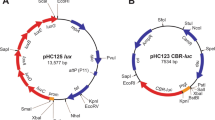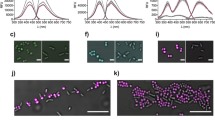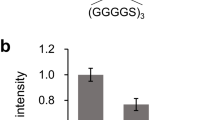Abstract
The need for the discovery of new antibiotics and solving the antibiotic resistance problem requires rapid detection of antibiotics, identification of known antibiotics, and prediction of antibiotic mechanisms. The bacterial lux genes encode proteins that convert chemical energy into photonic energy and lead to bioluminescence. Exploiting this phenomenon, we constructed a lux-based bioluminescence system in Staphylococcus aureus by expressing lux genes under the control of stress-inducible chaperon promoters. When experiencing antibiotic stress, these constructed reporter strains showed clear bioluminescence response. Therefore, this bioluminescence screening system can be used for the detection of antibiotics in unknown chemical mixtures. Further analysis of bioluminescence response patterns showed that: (1) these bioluminescence response patterns are highly antibiotic specific and therefore can be used for rapid and cheap identification of antibiotics; and that (2) antibiotics having the same mechanism of action have similar bioluminescence patterns and therefore these patterns can be used for the prediction of mechanism for an unknown antibiotic with good sensitivity and specificity. With this bioluminescence screening assay, the discovery and analysis of new antibiotics can be promoted, which benefits in solving the antibiotic resistance problem.
This is a preview of subscription content, access via your institution
Access options
Subscribe to this journal
Receive 12 print issues and online access
$259.00 per year
only $21.58 per issue
Buy this article
- Purchase on Springer Link
- Instant access to full article PDF
Prices may be subject to local taxes which are calculated during checkout




Similar content being viewed by others
References
Zhang QQ, Ying GG, Pan CG, Liu YS, Zhao JL. Comprehensive evaluation of antibiotics emission and fate in the river basins of China: source analysis, multimedia modeling, and linkage to bacterial resistance. Environ Sci Technol. 2015;49:6772–82.
Li L, et al. The genetic structures of an extensively drug resistant (XDR) Klebsiella pneumoniae and its plasmids. Front Cell Infect Microbiol. 2019;8:446.
Liu Y-Y, et al. Emergence of plasmid-mediated colistin resistance mechanism MCR-1 in animals and human beings in China: a microbiological and molecular biological study. Lancet Infect Dis. 2016;16:161–8.
O’Neill J. Tackling drug-resistant infections globally: final report and recommendations. 2016.
Li JWH, Vederas JC. Drug discovery and natural products: end of an era or an endless frontier? Science. 2009;325:161–5.
Baltz RH. Marcel Faber Roundtable: is our antibiotic pipeline unproductive because of starvation, constipation or lack of inspiration? J Ind Microbiol Biotechnol. 2006;33:507–13.
Greer LF, Szalay AA. Imaging of light emission from the expression of luciferases in living cells and organisms: a review. Luminescence. 2002;17:43–74.
Belas R, et al. Bacterial bioluminescence: isolation and expression of the luciferase genes from Vibrio harveyi. Science. 1982;218:43–74.
Andreu N, et al. Optimisation of bioluminescent reporters for use with mycobacteria. PLoS One. 2010;5:e10777.
Contag CH, et al. Photonic detection of bacterial pathogens in living hosts. Mol Microbiol. 1995;18:593–603.
Hall CA, Flick-Smith HC, Harding SV, Atkins HS, Titball RW. A bioluminescent Francisella tularensis SCHU S4 strain enables noninvasive tracking of bacterial dissemination and the evaluation of antibiotics in an inhalational mouse model of tularemia. Antimicrob Agents Chemother. 2016;60:7206–15.
Massey S, et al. In vivo bioluminescence imaging of Burkholderia mallei respiratory infection and treatment in the mouse model. Front Microbiol. 2011;2:174–83.
Mortin LI, et al. Rapid bactericidal activity of daptomycin against methicillin-resistant and methicillin-susceptible Staphylococcus aureus peritonitis in mice as measured with bioluminescent bacteria. Antimicrob Agents Chemother. 2007;51:1787–94.
Zhang T, Li SY, Nuermberger EL. Autoluminescent Mycobacterium tuberculosis for rapid, real-time, non-invasive assessment of drug and vaccine efficacy. PLoS ONE. 2012;7:e29774.
Lopes N, et al. Detection of dichloromethane with a bioluminescent (lux) bacterial bioreporter. J Ind Microbiol Biotechnol. 2012;39:45–53.
Prévéral S, et al. A bioluminescent arsenite biosensor designed for inline water analyzer. Environ Sci Pollut Res. 2017;24:25–32.
Kricka LJ. Clinical and biochemical applications of luciferases and luciferins. Anal Biochem. 1988;175:14–21.
Vocat A, et al. Bioluminescence for assessing drug potency against nonreplicating Mycobacterium tuberculosis. Antimicrob Agents Chemother. 2015;59:4012–9.
Andreu N, Fletcher T, Krishnan N, Wiles S, Robertson BD. Rapid measurement of antituberculosis drug activity in vitro and in macrophages using bioluminescence. J Antimicrob Chemother. 2012;67:404–14.
Sharma S, et al. Simple and rapid method to determine antimycobacterial potency of compounds by using autoluminescent Mycobacterium tuberculosis. Antimicrob Agents Chemother. 2014;58:5801–8.
Naran K, et al. Bioluminescent reporters for rapid mechanism of action assessment in tuberculosis drug discovery. Antimicrob Agents Chemother. 2016;60:6748–57.
Mesak LR, Qi S, Villanueva I, Miao V, Davies J. Staphylococcus aureus promoter-lux reporters for drug discovery. J Antibiot. 2010;63:492–8.
Horwich AL, Farr GW, Fenton WA. GroEL-GroES-mediated protein folding. Chem Rev. 2006;106:1917–30.
LaBreck CJ, May S, Viola MG, Conti J, Camberg JL. The protein chaperone ClpX targets native and non-native aggregated substrates for remodeling, disassembly, and degradation with ClpP. Front Mol Biosci. 2017;4:26.
Motohashi K, Taguchi H, Ishii N, Yoshida M. Isolation of the stable hexameric DnaK·DnaJ complex from Thermus thermophilus. J Biol Chem. 1994;269:27074–9.
Chapman E, et al. Global aggregation of newly translated proteins in an Escherichia coli strain deficient of the chaperonin GroEL. Proc Natl Acad Sci USA. 2006;103:15800–5.
Arita-Morioka K, Yamanaka K, Mizunoe Y, Ogura T, Sugimoto S. Novel strategy for biofilm inhibition by using small molecules targeting molecular chaperone DnaK. Antimicrob Agents Chemother. 2015;59:633–41.
Kim G, Akoolo L, Parker D. The ClpXP protease contributes to Staphylococcus aureus pneumonia. J Infect Dis. 2020. https://doi.org/10.1093/infdis/jiaa251.
Mesak LR, Yim G, Davies J. Improved lux reporters for use in Staphylococcus aureus. Plasmid. 2009;61:182–7.
Schneider CA, Rasband WS, Eliceiri KW. NIH Image to ImageJ: 25 years of image analysis. Nat Methods. 2012;9:671–5.
Kadar B, Kocsis B, Nagy K, Szabo D. The renaissance of polymyxins. Curr Med Chem. 2013;20:3759–73.
Gao R, et al. Dissemination and mechanism for the MCR-1 colistin resistance. PLoS Pathog. 2016;12:e1005957.
Van Bambeke F, Michot JM, Van Eldere J, Tulkens PM. Quinolones in 2005: an update. Clin Microbiol Infect. 2005;11:256–80.
Acknowledgements
This work was supported by the National Key Research and Development Program of China [Grant number 2017YFD0400301]; the National Natural Science Foundation of China [Grant numbers 31770042 and 31770043]; Shandong Province Key Research and Development Program [Grant numbers 2016GSF121040 and 2018GSF118008]; the Fundamental Research Funds of Shandong University [Grant numbers 2017JC028, 2018JC013, 2018JC027]; the State Key Laboratory of Microbial Technology Open Project Funds, Shandong University [Grant number M2018-07]; and Jinan Cultural Industry Development Fund. We would like to thank Prof. Julian Davies and Dr. Vivian Miao from University of British Columbia for kindly providing the pAmilux plasmid and good discussion on the work. We would like to thank Dr. Lili R. Mesak from University of British Columbia for helpful comments on our research strategy. We would also like to thank Dr. Haoxin Wang, Ms. Kun Zhang, Ms. Moli Sang, Ms. Yanan Ma, Ms. Wenya Su, Ms. Bianfang Wang, and Ms. Xin Wei from Shandong University for help during experiments. We would like to thank Mr. Xianbin Liu from the Core Facilities for Life and Environmental Sciences of Shandong University for assistance on bioluminescence detection.
Author information
Authors and Affiliations
Corresponding authors
Ethics declarations
Conflict of interest
The authors declare that there are no conflicts of interest.
Additional information
Publisher’s note Springer Nature remains neutral with regard to jurisdictional claims in published maps and institutional affiliations.
Supplementary information
Rights and permissions
About this article
Cite this article
Yang, Z., Cui, Q., Zhang, M. et al. A lux-based Staphylococcus aureus bioluminescence screening assay for the detection/identification of antibiotics and prediction of antibiotic mechanisms. J Antibiot 73, 828–836 (2020). https://doi.org/10.1038/s41429-020-0349-7
Received:
Revised:
Accepted:
Published:
Issue Date:
DOI: https://doi.org/10.1038/s41429-020-0349-7



